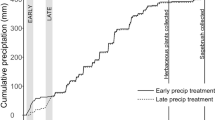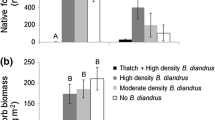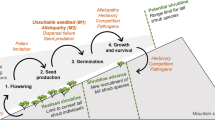Abstract
Competitive suppression of native species has long been considered among the most important mechanisms allowing exotic plants to dominate some communities, but recent work has focused attention on the potential role of native seed limitation. We tested effects of competition from exotic annual grasses and seed limitation on the abundances of four native annual plants in invaded southern California grassland for two different years. Both initial responses and effects still present 1–3 years later were measured. In the wetter year of 2006, all four native species (Amsinckia menziesii var. intermedia, Phacelia distans, Camissonia bistorta and Clarkia purpurea ssp. quadrivulnera) increased in abundance with exotic grass removal, and two (Clarkia and Camissonia) responded significantly to seed addition. We observed limited treatment effects during the much drier growing season of 2007. By 2008–2009, any initial effects of exotic grass removal had disappeared. However, for both the 2006 and 2007 experiments seeding significantly increased native cover in 2009, independent of initial grass removal. Abundances of both Amsinckia and Phacelia, but not Camissonia or Clarkia, were significantly higher in seeded plots during 2008–2009. These delayed responses may have resulted from seed dormancy. Our results support the importance of both competition with exotics and seed limitation in determining native annual community composition of California grasslands. An interesting future question is whether traits related to resource use or germination phenology may predict differences in native species interactions with exotic grasses.





Similar content being viewed by others
References
Abraham JK, Corbin JD, D’Antonio CM (2009) California native and exotic perennial grasses differ in their response to soil nitrogen, exotic annual grass density, and order of emergence. Plant Ecol 201:445–456. doi:10.1007/s11258-008-9467-1
Bolker B, Skaug H, Magnusson A, Nielsen A (2012) Getting started with the glmmADMB package. http://glmmadmb.r-forge.r-project.org/glmmADMB.html
Brandt AJ, Seabloom EW (2012) Seed and establishment limitation contribute to long-term native forb declines in California grasslands. Ecology 93:1451–1462
Clark CJ, Poulsen JR, Levey DJ, Osenberg CW (2007) Are plant populations seed limited? A critique and meta-analysis of seed addition experiments. Am Nat 170:128–142. doi:10.1086/518565
Cleland EE, Larios L, Suding KN (2013) Strengthening invasion filters to reassemble native plant communities: soil resources and phenological overlap. Restor Ecol 21:390–398. doi:10.1111/j.1526-100X.2012.00896.x
Coleman HM, Levine JM (2007) Mechanisms underlying the impacts of exotic annual grasses in a coastal California meadow. Biol Invasions 9:65–71. doi:10.1007/s10530-006-9008-6
Corbin JD, D’Antonio CM (2004) Can carbon addition increase competitiveness of native grasses? A case study from California. Restor Ecol 12:36–43. doi:10.1111/j.1061-2971.2004.00299.x
Cox RD, Allen EB (2008) Stability of exotic annual grasses following restoration efforts in southern California coastal sage scrub. J Appl Ecol 45:495–504. doi:10.1111/j.1365-2664.2007.01437.x
Didham RK, Tylianakis JM, Hutchison MA, Ewers RM, Gemmell NJ (2005) Are invasive species the drivers of ecological change? TREE 20:470–474. doi:10.1016/j.tree.2005.07.006
DiVittorio CT, Corbin JD, D’Antonio CM (2007) Spatial and temporal patterns of seed dispersal: an important determinant of grassland invasion. Ecol Appl 17:311–316. doi:10.1890/06-0610
Drenovsky RE et al (2012) A functional trait perspective on plant invasion. Ann Bot 110:141–153. doi:10.1093/aob/mcs100
Fenn ME et al (2010) Nitrogen critical loads and management alternatives for N-impacted ecosystems in California. J Environ Manag 91:2404–2423. doi:10.1016/j.jenvman.2010.07.034
Forbis TA (2010) Germination phenology of some Great Basin native annual forb species. Plant Species Biol 25:221–230. doi:10.1111/j.1442-1984.2010.00289.x
Fournier DA et al (2012) AD Model Builder: using automatic differentiation for statistical inference of highly parameterized complex nonlinear models. Optim Method Softw 27:233–249. doi:10.1080/10556788.2011.597854
Funk JL, Cleland EE, Suding KN, Zavaleta ES (2008) Restoration through reassembly: plant traits and invasion resistance. TREE 23:695–703. doi:10.1016/j.tree.2008.07.013
Funk JL, Hoffacker MK, Matzek V (2015) Summer irrigation, grazing and seed addition differentially influence community composition in an invaded serpentine grassland. Restor Ecol 23:122–130. doi:10.1111/rec.12162
Gioria M, Osborne BA (2014) Resource competition in plant invasions: emerging patterns and research needs. Front Plant Sci. doi:10.3389/fpls.2014.00501
Grman E, Suding KN (2010) Within-year soil legacies contribute to strong priority effects of exotics on native California grassland communities. Restor Ecol 18:664–670. doi:10.1111/j.1526-100X.2008.00497.x
Gross N, Liancourt P, Butters R, Duncan RP, Hulme PE (2015) Functional equivalence, competitive hierarchy and facilitation determine species coexistence in highly invaded grasslands. New Phyt 206:175–186. doi:10.1111/nph.13168
Hilbig BE, Allen EB (2015) Plant-soil feedbacks and competitive interactions between invasive Bromus diandrus and native forb species. Plant Soil 392:191–203. doi:10.1007/s11104-015-2451-3
HilleRisLambers J, Yelenik SG, Colman BP, Levine JM (2010) California annual grass invaders: the drivers or passengers of change? J Ecol 98:1147–1156. doi:10.1111/j.1365-2745.2010.01706.x
James JJ, Drenovsky RE, Monaco TA, Rinella MJ (2011) Managing soil nitrogen to restore annual grass-infested plant communities: effective strategy or incomplete framework? Ecol Appl 21:490–502. doi:10.1890/10-0280.1
Leger EA, Espeland EK (2010) The shifting balance of facilitation and competition affects the outcome of intra- and interspecific interactions over the life history of California grassland annuals. Plant Ecol 208:333–345. doi:10.1007/s11258-009-9710-4
Levine JM, Rees M (2004) Effects of temporal variability on rare plant persistence in annual systems. Am Nat 164:350–363. doi:10.1086/422859
Levine JM, Vila M, D’Antonio CM, Dukes JS, Grigulis K, Lavorel S (2003) Mechanisms underlying the impacts of exotic plant invasions. Proc R Soc B 270:775–781. doi:10.1098/rspb.2003.2327
Liu H, Stiling P (2006) Testing the enemy release hypothesis: a review and meta-analysis. Biol Invasions 8:1535–1545. doi:10.1007/s10530-005-5845-y
MacDougall AS, Turkington R (2005) Are invasive species the drivers or passengers of change in degraded ecosystems? Ecology 86:42–55. doi:10.1890/04-0669
MacDougall AS, Wilson SD, Bakker JD (2008) Climatic variability alters the outcome of long-term community assembly. J Ecol 96:346–354. doi:10.1111/j.1365-2745.2007.01333.x
Mack RN, Simberloff D, Lonsdale WM, Evans H, Clout M, Bazzaz FA (2000) Biotic invasions: causes, epidemiology, global consequences, and control. Ecol Appl 10:689–710. doi:10.2307/2641039
Maire V et al (2012) Habitat filtering and niche differentiation jointly explain species relative abundance within grassland communities along fertility and disturbance gradients. New Phyt 196:497–509. doi:10.1111/j.1469-8137.2012.04287.x
Maron JL, Marler M (2008) Field-based competitive impacts between invaders and natives at varying resource supply. J Ecol 96:1187–1197. doi:10.1111/j.1365-2745.2008.01440.x
Mayfield MM, Dwyer JM, Main A, Levine JM (2014) The germination strategies of widespread annual plants are unrelated to regional climate. Global Ecol Biog 23:1430–1439. doi:10.1111/geb.12219
Pec GJ, Carlton GC (2014) Positive effects of non-native grasses on the growth of a native annual in a southern California ecosystem. PLoS One. doi:10.1371/journal.pone.0112437
Rinella MJ, Mangold JM, Espeland EK, Sheley RL, Jacobs JS (2012) Long-term population dynamics of seeded plants in invaded grasslands. Ecol Appl 22:1320–1329
Seabloom EW (2011) Spatial and temporal variability in propagule limitation of California native grasses. Oikos 120:291–301. doi:10.1111/j.1600-0706.2010.18781.x
Seabloom EW et al (2003a) Competition, seed limitation, disturbance, and reestablishment of California native annual forbs. Ecol Appl 13:575–592
Seabloom EW, Harpole WS, Reichman OJ, Tilman D (2003b) Invasion, competitive dominance, and resource use by exotic and native California grassland species. PNAS 100:13384–13389. doi:10.1073/pnas.1835728100
Skurski TC, Rew LJ, Maxwell BD (2014) Mechanisms underlying nonindigenous plant impacts: a review of recent experimental research. Invasive Plant Sci Manag 7:432–444. doi:10.1614/ipsm-d-13-00099.1
Steers RJ, Funk JL, Allen EB (2011) Can resource-use traits predict native versus exotic plant success in carbon amended soils? Ecol Appl 21:1211–1224. doi:10.1890/09-2345.1
Wainwright CE, Cleland EE (2013) Exotic species display greater germination plasticity and higher germination rates than native species across multiple cues. Biol Invasions 15:2253–2264. doi:10.1007/s10530-013-0449-4
Wainwright CE, Wolkovich EM, Cleland EE (2012) Seasonal priority effects: implications for invasion and restoration in a semi-arid system. J Appl Ecol 49:234–241. doi:10.1111/j.1365-2664.2011.02088.x
Acknowledgments
We thank L. Ng, E. Hashimoto, C. Gurney, K. Janes, J. Shih, and M. Ward for their help with field work; S. Schenk for plant identification; E. Crone, B. Elderd, and B. Teller for their assistance with statistics; and E. Espeland and several anonymous reviewers for helpful comments on the MS. Funding was provided by the W. M. Keck and the A. W. Mellon Foundations through the Keck Science Department.
Author information
Authors and Affiliations
Corresponding author
Additional information
Communicated by Luke Flory.
Electronic supplementary material
Below is the link to the electronic supplementary material.
Rights and permissions
About this article
Cite this article
Thomson, D.M., Cruz-de Hoyos, R., Cummings, K. et al. Why are native annual abundances low in invaded grasslands? Testing the effects of competition and seed limitation. Plant Ecol 217, 431–442 (2016). https://doi.org/10.1007/s11258-016-0584-y
Received:
Accepted:
Published:
Issue Date:
DOI: https://doi.org/10.1007/s11258-016-0584-y




